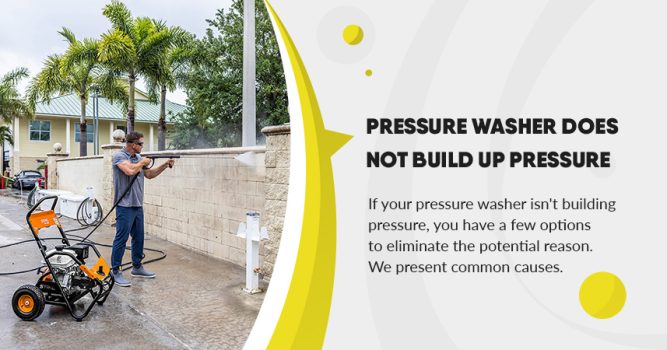

If a high-pressure washer does not build up pressure, there are two reasons. Either the closed pressure system is leaking at some point or there is a technical defect. Technical defects often include clogged components such as filters or valves and excess air in the system. In most cases, the malfunction can be easily remedied.
First check and rule out all self-rectifiable causes
A widespread defect is a fault in the pressure build-up. The damage patterns range from complete pressure loss to intermittent pressure build-up to stuttering. The cause may be relatively minor. However, an elementary technical defect, often caused by worn parts, is also possible.
Also of interest:
- Pressure Washer Troubleshooting
- Gun repair on a pressure washer
- Pressure washer won’t start
- Pressure washer hose repair
- Why does the gun on a pressure washer leak?
The following possible causes should be checked in this order before calling for a service or a workshop:
1. Check power and water supply
- Socket under power
- Fuse in order
- Check for broken cable
- Open the water tap completely
- Check the water pressure and flow rate at the tap.
- Check that the water inlet hose has a minimum cross-section of 19 millimetres (three-quarters of an inch).
2. Leakage, air or leakage
- Check pressure hose for damage
- Check pressure gun for leakage
- Dismantle hose, run unit to bleed air until no more air comes out
3. Dirt or blockage
- Clean water filter at water inlet
- Pierce” the high-pressure nozzle with a needle or nail.
- Rinse pressure gun with water
- Pressure or suction valves dirty, open in the pump head at hexagonal screws, clean and reinsert
4. Component defect (must be repaired professionally)
- Pressure or suction valves defective
- Defective pump motor
- Defective pump impeller
- Seals worn and leaking
- Leaky pump housing (also water leakage at the lower unit housing)
Another cause can be the replacement of a component such as a longer hose. If the dimensions in the cross-section are not sufficient, this can disrupt operation. If a new component has been installed externally, e.g. in a customer service workshop, it is advisable to carry out a test run on site.







